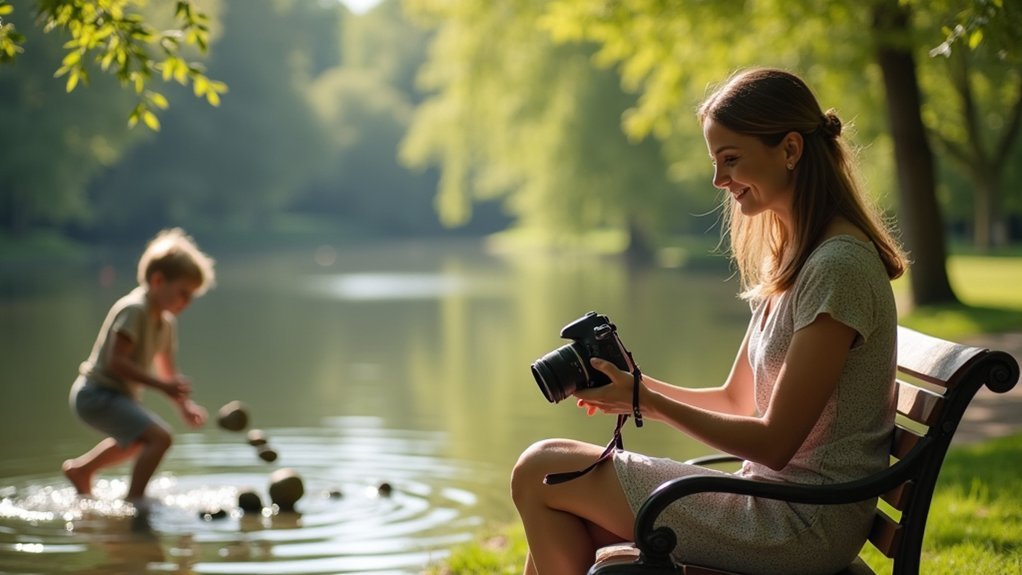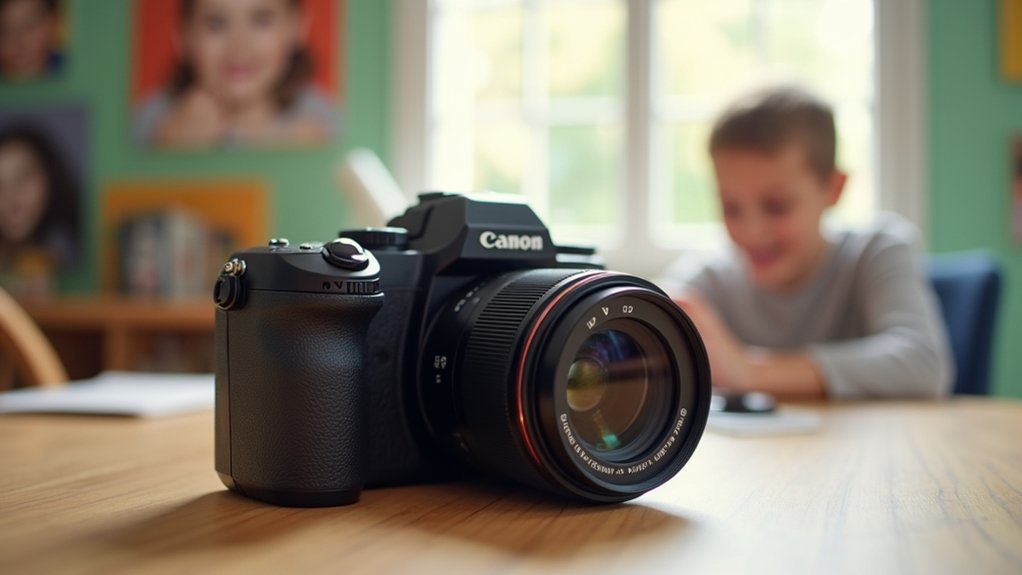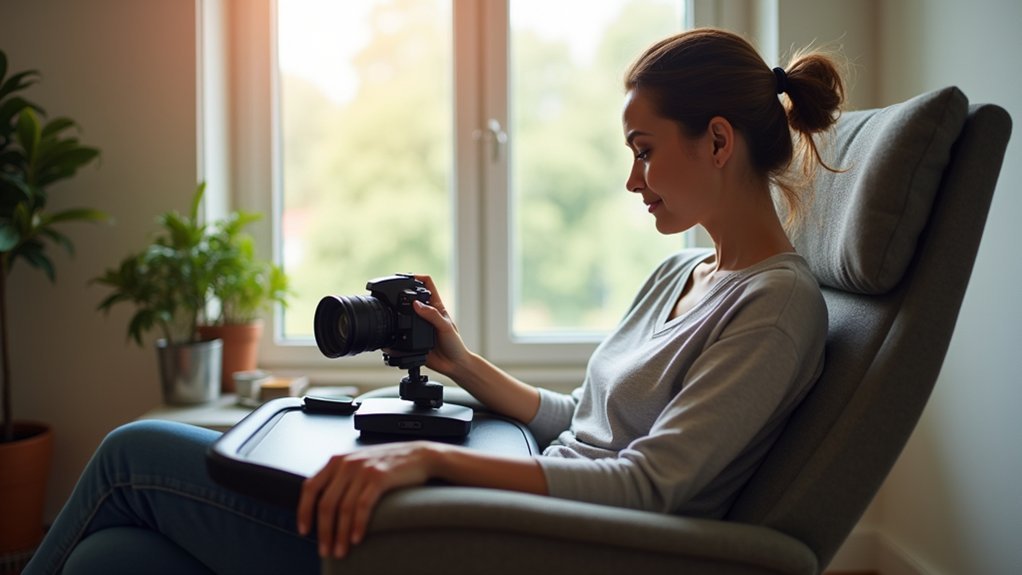For shake-free photos with tremors, use faster shutter speeds, higher ISO settings, and cameras with built-in stabilization. Try tripods, monopods, or weighted stabilizers to improve stability. Remote shutter releases or voice controls eliminate physical button presses. Position your elbows against your body and exhale before shooting. Smartphone users can benefit from grip-enhancing cases and gimbals. Post-processing tools like Photoshop’s Smart Sharpen can rescue slightly blurry images. Explore these techniques to transform your photography experience.
Shake-Free Photos for People With Tremors

While tremors can make photography challenging, they don’t have to prevent you from capturing beautiful images. Consider investing in stabilizing equipment like a tripod for maximum stability or a monopod when you need more mobility. Remote shutter releases eliminate the need to touch your camera during exposure.
Adjust your camera settings strategically—faster shutter speeds, higher ISO, and wider apertures all help combat shake. When shooting handheld, pull your elbows tightly against your body, exhale before pressing the shutter, and use your environment for support. Modern cameras with built-in image stabilization can significantly reduce the impact of tremors on your photography.
Don’t hesitate to embrace your tremors creatively—sometimes motion blur adds artistic flair to images. You can also try smartphone holders, camera self-timers, or explore video modes with frame capture options when still photography proves difficult.
Understanding Tremors and Photography Challenges
Tremors, whether they’re rest tremors (occurring when your hands are still) or action tremors (happening during movement), create unique challenges when you’re trying to capture photos.
Your camera shake from these involuntary movements often leads to blurry images, particularly during longer exposures or when using zoom lenses.
Understanding your specific tremor pattern helps identify which photography techniques and stabilization tools will work best for your situation. For people with essential tremor, the most common movement disorder, photography can be especially difficult as it affects the hands with 4 to 11 Hz frequency oscillations.
Tremors Types Explained
Understanding different tremor types is essential if you’re struggling with shaky photography due to hand tremors.
You might experience resting tremors (visible when your hands are inactive) or action tremors that appear during movement. The latter includes postural tremors when holding your camera up and kinetic tremors during the actual photo-taking.
Tremors can be classified by their cause: essential tremor (often hereditary), Parkinsonian tremor (3-6 Hz frequency), or enhanced physiologic tremor triggered by stress or medications. Essential tremor is the most common pathologic tremor, affecting 0.4% to 6% of the population.
They also vary in frequency (low, medium, high), amplitude (fine or coarse), and distribution (affecting specific body parts).
Knowing your tremor type helps in finding appropriate solutions for photography, whether through medication, assistive devices, or specialized techniques designed for your particular tremor pattern.
Photography-specific Limitations
When taking photographs with hand tremors, you’ll encounter specific technical challenges that directly affect image quality.
Most importantly, camera shake leads to blurred images, especially at slower shutter speeds where even minimal movement becomes visible in your photos.
Your ability to capture sharp images in low light becomes particularly difficult since these conditions typically require longer exposures.
Hand tremors also complicate manual focusing and precise framing of shots. You’ll often need to compensate by using faster shutter speeds, which then requires adjusting ISO or aperture settings.
The precise control required for macro photography or telephoto shots becomes especially challenging, as these techniques magnify even slight movements.
Using techniques like finding solid support can significantly improve stability when traditional handheld shooting isn’t feasible for those with tremors.
While modern technology offers solutions, understanding these fundamental limitations helps you develop effective workarounds for your specific tremor pattern.
Specialized Camera Stabilization Equipment for Tremor Conditions

You’ll find relief with adaptive grips that reshape your camera’s handling to accommodate your specific tremor patterns.
Weighted stabilizer systems add counterbalance to your setup, effectively dampening the impact of involuntary movements while shooting.
These specialized solutions combine customizable elements with strategic weight distribution to transform potentially frustrating photo sessions into confident creative experiences. Consider using non-invasive technology similar to modern tremor-reduction gloves that provide real-time stabilization without requiring batteries.
Adaptive Grip Solutions
For those with tremor conditions, specialized camera stabilization equipment offers newfound creative freedom. When your hands shake, adaptive grips featuring 3-axis gimbals can counteract unwanted movements through motion sensors and advanced algorithms.
You’ll find camera mounts designed specifically to maintain stability during use, with adjustable features to accommodate various camera weights. Tremor stabilizer devices support your hand, wrist, and forearm while incorporating gyroscopes to neutralize tremors without restricting your creative control.
These non-invasive solutions prioritize ergonomic comfort while reducing tremor amplitude. Consider a FDA-cleared wearable device like the Cala kIQ™ System that provides tremor relief while you pursue photography. Whether you’re shooting landscapes or portraits, the secure mounting bands keep everything steady.
Remember that motorized options require regular charging, but the freedom to capture shake-free images makes this minor inconvenience worthwhile.
Weighted Stabilizer Systems
Beyond adaptive grips, weighted stabilizer systems offer a physics-based approach to countering tremors. These devices leverage mass and inertia to resist unwanted movement, with heavier cameras naturally providing more stability during operation.
You’ll find several options to match your needs: handheld stabilizers for basic steadiness, 3-axis gimbals for smooth motion across all movement planes, and vest systems that distribute weight for extended shooting sessions.
Motorized gimbals automatically adjust to counteract shake, requiring less manual control than passive alternatives. These advanced options use motion sensors to detect unwanted movement and apply precise corrections, making them especially valuable for those with tremor conditions.
When selecting a stabilizer, consider its weight capacity, portability, and your comfort level with its complexity. While professional Steadicam systems offer exceptional stability, they require practice to master.
For severe tremors, keep an eye on emerging active damper technology specifically designed to counteract tremor movements.
Adapting Photography Techniques for Hand Tremors
Living with hand tremors doesn’t mean giving up photography altogether; it simply requires adapting your approach to accommodate these natural movements. Stabilize your camera by pulling your elbows into your body and wrapping the strap around your arm for added support.
Photography with tremors is about adaptation, not limitation. Simple technique adjustments can transform shaky hands into steady shots.
Choose wide-angle lenses and faster shutter speeds to minimize shake effects. Enable image stabilization and use burst mode to increase your chances of capturing clear shots.
When positioning yourself, stand with feet shoulder-width apart and try raising your left shoulder slightly while relaxing your muscles. Creating a human tripod position by sitting with one knee raised can provide exceptional stability for photographers dealing with tremors.
Don’t forget to exhale before pressing the shutter. Consider using a remote release or timer function to eliminate the shake from button pressing.
Custom Grip Solutions and Modified Camera Controls

While standard cameras can be challenging for photographers with tremors, custom grip solutions offer a transformative way to regain control and stability. These specially designed grips fit your unique hand size and needs, reducing fatigue during extended photography sessions.
Look for grips made from durable aluminum that distribute weight evenly and minimize vibrations. Many feature ergonomic designs that reduce finger movement and include customizable interfaces for quick access to frequently used settings.
For maximum stability, consider integrating your grip with electronic stabilization systems or gimbals. These combinations greatly enhance image smoothness while maintaining comfort.
Custom grip kits are available for specific camera models and often include adjustable features to personalize height and position. The textured grip materials provide exceptional control in challenging weather conditions like rain or cold.
When selecting a grip, prioritize ergonomics, adjustability, and balanced weight distribution to create your ideal photography setup.
Electronic Stabilization Technology and Assistive Features
Beyond physical solutions like custom grips, electronic stabilization technology offers powerful options for photographers with tremors. Electronic Image Stabilization (EIS) works by digitally analyzing frames and counteracting shake in real-time, giving you clearer images without expensive equipment. Built-in gyroscopic sensors detect camera movements and vibrations, significantly improving the stability of your photos.
| Feature | Benefit |
|---|---|
| Digital cropping | Creates buffer zone for image shifting |
| Gyroscopic sensors | Provides precise movement data |
| Real-time algorithms | Adapts to varying tremor intensities |
| AI-driven stabilization | Predicts and corrects motion patterns |
| Hybrid stabilization | Combines electronic and optical systems |
While EIS slightly reduces field of view, it’s remarkably effective for everyday photography. For best results, look for cameras with both gyroscopic sensors and EIS—this combination delivers superior stabilization by physically tracking motion while digitally correcting frames.
Selecting Tremor-Friendly Camera Models

Choosing the right camera can dramatically improve your photography experience when managing tremors. Focus on models with in-body image stabilization (IBIS) like Panasonic Lumix, Sony mirrorless, or Nikon Z series cameras. These systems compensate for hand movements, reducing blur in your photos.
The right camera with quality IBIS technology makes all the difference when pursuing photography despite tremors.
Consider these key factors when selecting your camera:
- Weight and ergonomics – lighter cameras like Micro Four Thirds systems are easier to handle with tremors
- Built-in stabilization – look for cameras with 5-axis IBIS for maximum shake reduction
- Shutter speed capabilities – models that perform well at higher shutter speeds help freeze motion
- Compatibility with remote triggers and tripods – these accessories provide additional stability options
Tactile analog dials found on models like the Nikon Zfc can be significantly easier to manipulate than touch screens for photographers with Essential Tremor.
Remember that full-frame L-Mount cameras and bridge cameras can also offer excellent stability features.
Smartphone Photography Adaptations for Tremor Management
Your smartphone can become a reliable photography tool despite hand tremors with the right adaptations.
Consider adding grip-enhancing accessories like rubberized cases or pop sockets that’ll provide more stability during shooting.
You’ll also benefit from voice-activated shooting options and tripod-mounted solutions that eliminate the need to physically press buttons.
Remember to keep your elbows tucked close to your body for additional stability when taking handheld shots.
Grip-Enhancing Phone Accessories
For individuals with tremors, maintaining a steady grip on a smartphone can be especially challenging when trying to capture clear, blur-free photos.
Specialized accessories can greatly improve your photography experience by enhancing stability and control.
- Weighted phone cases add stabilizing heft to your device, naturally reducing tremor-induced movement while shooting.
- Textured grip sleeves wrap around your phone to prevent slipping and provide better hand control during photo sessions.
- Ergonomic phone holders conform to your hand’s natural position, minimizing strain and tremor effects.
- Smartphone stabilizers or gimbals actively compensate for hand movements, ensuring smoother results even with pronounced tremors.
These accessories work on the same principle as weighted utensils that help stabilize hands during eating, applying similar technology to photography.
These accessories don’t just prevent drops—they transform your photography experience, allowing you to capture important moments without frustration.
Voice-Activated Shooting Options
When physical button presses become challenging due to tremors, voice-activated camera features offer an elegant solution for capturing shake-free photos. Both iOS and Android devices provide built-in voice command capabilities.
On iOS, ask Siri to “take a picture” or “open camera.” Android users can enable voice commands in camera settings and use triggers like “smile,” “cheese,” or “capture” to shoot without touching the phone. For additional control, enabling Voice Control in Accessibility Settings allows for a comprehensive hands-free photography experience.
| Platform | Voice Commands | Benefits for Tremor Management |
|---|---|---|
| iOS | “Hey Siri, take a picture” | Completely hands-free operation |
| Android | “Cheese” or “Capture” | Reduces physical interaction |
| iOS | “Open camera app” | Easy access without navigation |
| Android | “OK Google, take a selfie” | Automatic front camera activation |
| Both | Custom voice assistant shortcuts | Personalized for your needs |
Tripod-Mounted Phone Solutions
Tripod-mounted smartphone solutions offer a physical stability approach that complements voice commands for those managing hand tremors.
These setups eliminate camera shake, allowing you to capture crisp, clear images even in challenging low-light conditions where tremors are most noticeable.
When using a tripod with your smartphone, you’ll need:
- A phone-specific mount or universal adapter to secure your device
- A remote shutter or timer function to avoid touching the phone during capture
- A portable tripod option if you’re frequently on the move
- A level surface or stabilizing accessories for outdoor photography
While tripods require some setup time and practice, they’re incredibly effective for planned photography sessions.
For activities with inherent vibration, consider adding a specialized vibration dampener that screws directly into your tripod mount for significantly improved stability.
Pair your tripod with your phone’s built-in stabilization features for maximum shake reduction and professional-quality results.
Remote Triggering Options for Hands-Off Photography
While essential tremors can make traditional shutter button pressing nearly impossible, remote triggering systems offer a revolutionary solution for photographers with hand tremors. These devices eliminate camera shake by removing the need for physical contact with your camera.
You’ll find multiple options to suit your needs: infrared remotes work at short distances, while radio frequency triggers offer greater range. For smartphone integration, Bluetooth and Wi-Fi connectivity let you control your camera through user-friendly apps that provide real-time feedback and adjustments.
These triggers are particularly valuable for long exposures and time-lapse photography, where stability is vital. Many are compatible with major camera brands and offer features like timing control and multiple shot modes, ensuring you can capture perfect moments despite hand tremors. Remote releases with intervalometer functionality also allow for capturing stunning time-lapse sequences automatically at precise intervals.
Practical Positioning and Support Strategies

Despite the challenges tremors present, mastering proper positioning and support techniques can greatly improve your photography results.
Try sitting down with your elbows resting on your knees to create a more stable platform, or lie down to place your camera directly on a solid surface. When standing, brace yourself against walls, trees, or other fixed objects. Tucking your elbows in against your body creates a stable foundation for steadier shots.
- Create a makeshift tripod with your knee for low-angle shots
- Position your left hand under your right bicep for additional stability
- Use your fist as a platform when lying down to achieve better angles
- Adapt your position based on environmental conditions (like wind)
These positioning strategies work well alongside optimized camera settings and can considerably reduce the impact of tremors on your images.
Post-Processing Solutions for Shake Correction
Even the shakiest photos can often be salvaged with the right post-processing techniques.
Start by using Photoshop’s Smart Sharpen filter to remove motion blur, adjusting the angle and amount based on your specific tremor pattern.
Combine this with selective histogram and exposure adjustments to enhance image stability.
For particularly challenging shots, try AI-powered shake correction tools which can intelligently analyze and fix camera movement issues.
Don’t overlook image stacking—combining multiple shots of the same scene can effectively neutralize shake effects.
When working with high ISO images, balance noise reduction with sharpening to maintain detail without amplifying blur. Consider using DxO’s DeepPRIME noise reduction which is highly effective at preserving details while minimizing noise artifacts.
Establish an efficient workflow using non-destructive editing techniques so you can experiment without damaging your original files.
With these digital solutions, tremors won’t prevent you from creating crisp, clear images.
Frequently Asked Questions
Can Photography Be Therapeutic for People With Tremors?
Photography can be therapeutic for you if you have tremors. It’s a creative distraction that enhances your mood, reduces stress, and builds self-esteem while encouraging social interaction and physical movement.
Are There Photography Communities Specifically for Photographers With Tremors?
While no formal communities exclusively for photographers with tremors exist, you’ll find support through Parkinson’s groups, social media networks, equipment forums, and local art guilds that welcome and showcase your unique photographic perspective.
How Do Weather Conditions Affect Tremor Severity During Photography?
Cold weather can worsen your tremors while humidity may stiffen joints. You’ll also face challenges from wind that adds camera movement. Stress from poor weather conditions might indirectly increase your tremor severity too.
Does Caffeine Consumption Significantly Impact Tremor-Related Camera Shake?
Yes, caffeine can worsen your camera shake if you have essential tremor, with 8% of ET patients reporting increased tremors. You’ll likely notice less impact if you have Parkinson’s disease, where caffeine may actually help.
Are There Insurance Options Covering Specialized Equipment for Photographers With Tremors?
Yes, you’ll find some insurance policies cover specialized photography equipment for tremors. Look for customizable plans that include adaptive gear protection and consider photographers’ insurance that accommodates disabilities in their coverage options.
In Summary
You’re not defined by your tremors. With specialized equipment, custom grips, remote triggers, and post-processing tools, you’ll find photography remains accessible and rewarding. Try different techniques until you discover what works for your specific needs. Remember, it’s not about taking perfectly steady shots every time—it’s about expressing your unique vision through photography, regardless of physical challenges.





Leave a Reply